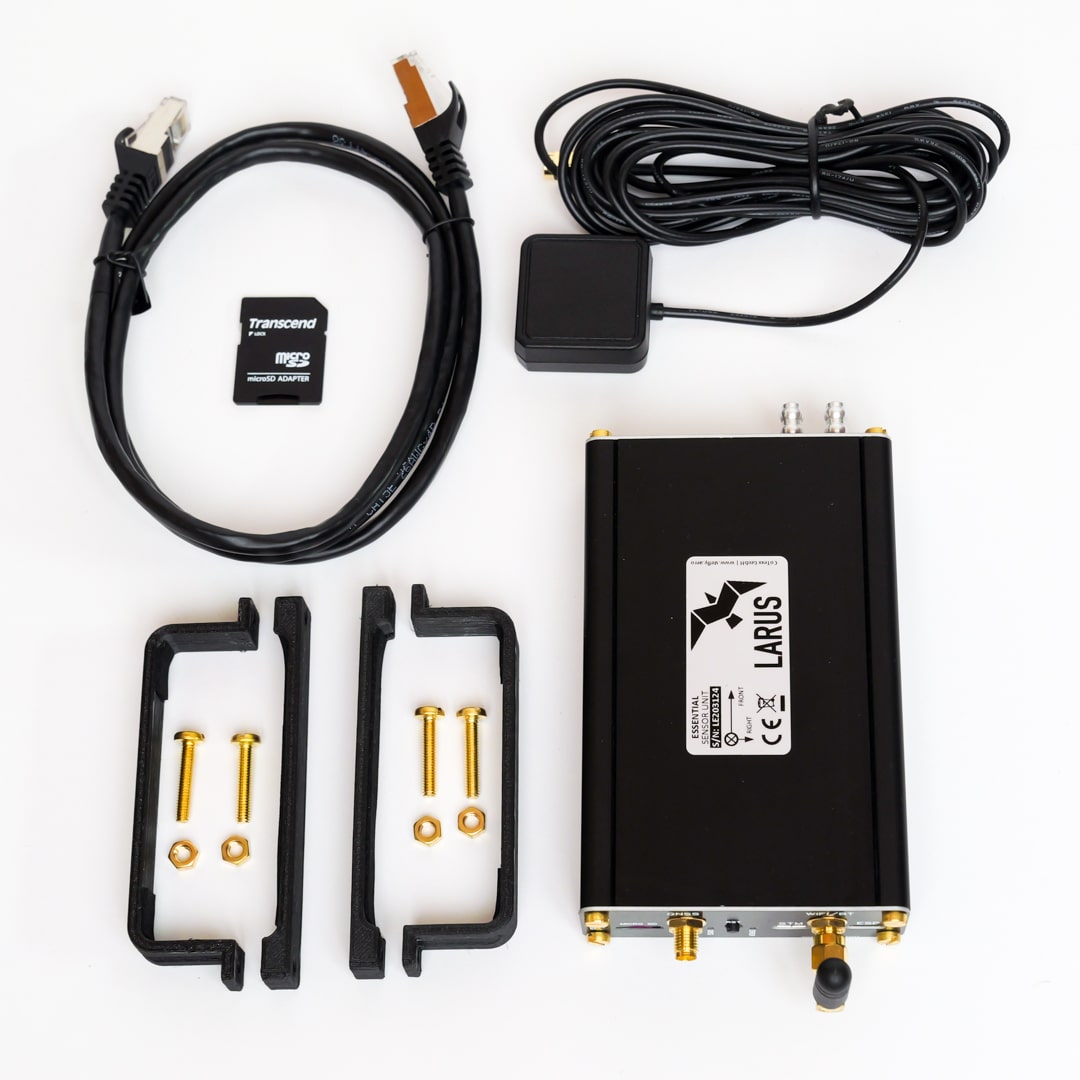LARUS Gliding Sensor Unit
1.292,34 € – 2.082,50 €
incl. VAT plus shipping
LARUS Sensoreinheit mit Gehäuse und Elektronik. Zur Anzeige der Daten wird ein separates Anzeigegerät benötigt wie z.B. Larus Varioanzeige, ein SteFly NAV oder ein Bluetooth-fähiges Gerät mit XCSoar.
- LARUS sensor unit in black anodized aluminum housing
- 1 GNSS antenna (LARUS Essential) or 2 GNSS antennas (LARUS Dual-GNSS)
- Brass mounting screws and nuts
- 2 Fastening clamps
- 4GB Micro SD card with adapter
- RJ45 cable 1 m
Delivery time: 5-7 business days
High end variometer. Precise real-time wind determination. Artificial horizon.
The Larus sensor unit goes into series production and is now available from SteFly in the Essential or Dual-GNSS version!
Nach mehreren Jahren Entwicklung und Erprobung durch das LARUS-Projektteam um Dr. Klaus Schäfer, Horst Rupp und Maximilian Betz wird das High-End Variometer nun in Serie in Lizenz produziert.

The philosophy: better to measure than to estimate!
With high-precision sensors and GNSS receivers combined with sophisticated algorithms, the direction and strength of thermals and wind can be calculated extremely quickly and reliably.


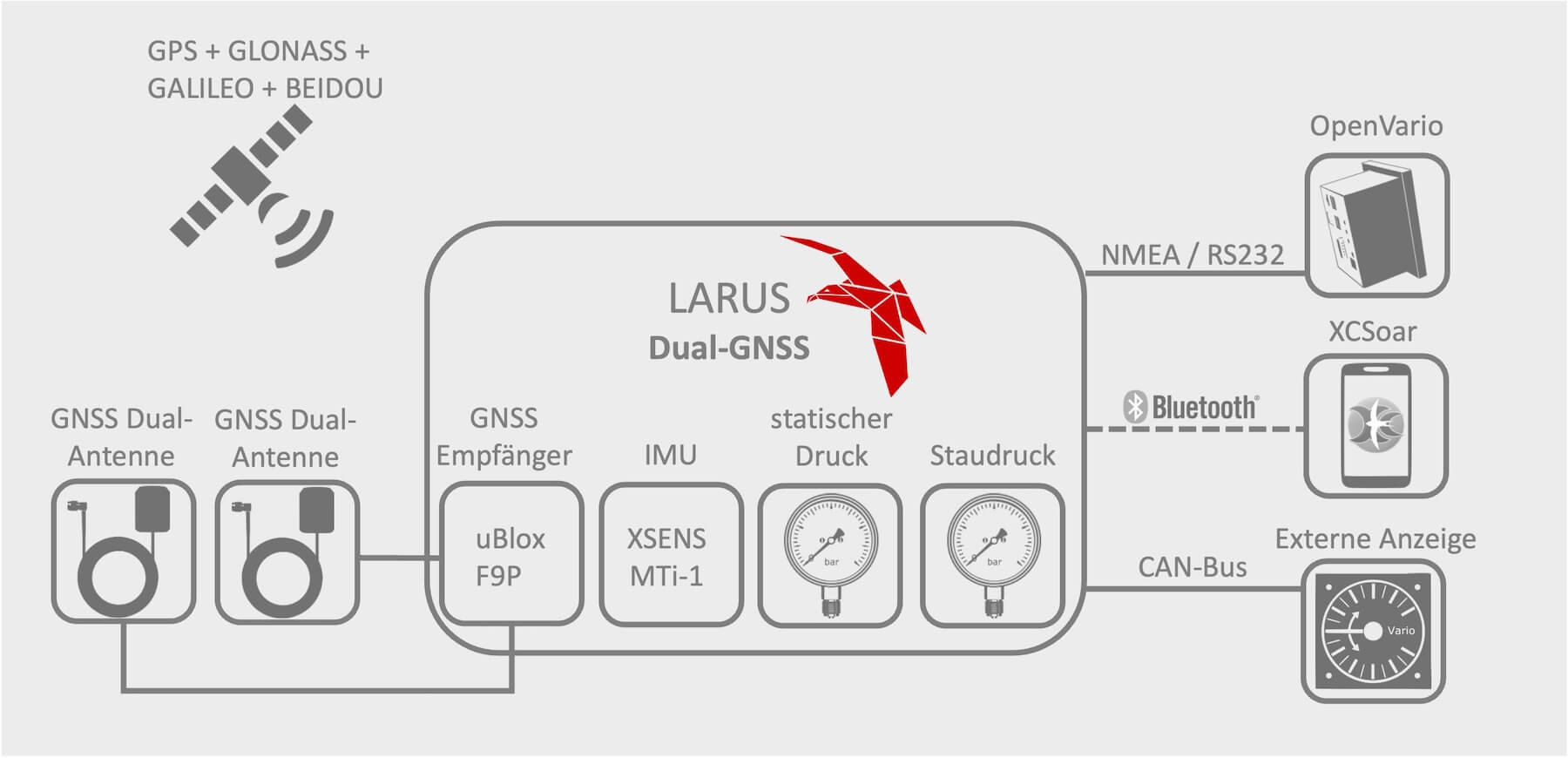
How does LARUS work?
In short: Data from one (or two) GNSS receiver(s), an IMU (inertial measurement unit) and pressure sensors for static pressure and dynamic pressure are combined and evaluated in the LARUS sensor unit using special algorithms. The results are transferred to a display device via a serial interface or Bluetooth. For example, all OpenVarios or other devices running XCSoar are compatible with the LARUS sensor unit.
In principle, LARUS calculates:
- Energy-compensated climb or sink (variometer)
- Horizontal wind speed as an instantaneous value (live / real-time wind) and a value averaged over an adjustable period (e.g. 30 s)
- Attitude for display in an artificial horizon
- Pressure altitude / flight level FL
- True airspeed (TAS)
- Course over the ground (track)
- Drift angle (difference between track and heading)
In the Essential variant, LARUS has installed a precise GNSS receiver with an external active antenna. In the LARUS Dual-GNSS variant, on the other hand, a high-precision dual-band receiver is connected to two active, multi-frequency band antennas.
Central components of the LARUS sensor box and their tasks in detail
GNSS
In recent years, location determination using GNSS (Global Navigation Satellite System) has become much more accurate. Because GNSS also includes satellites from GLONASS, Galileo and BeiDou in addition to GPS satellites, the modern GNSS receivers installed in the LARUS sensor box can achieve a horizontal positioning accuracy of 1.5 - 2 m. In addition, the ground speed is measured three-dimensionally and used to support the flight attitude measurement and as a measured variable for the variometer.
The accuracy of the speed measurement is:
- LARUS Essential with uBlox M9N single-frequency receiver and GNSS antenna: horizontal approx. 0.1 km/h; vertically approx. 5 cm/s
- LARUS Dual GNSS with uBlox F9P dual GNSS receiver: horizontal approx. 0.05 km/h; vertically approx. 2.5 cm/s
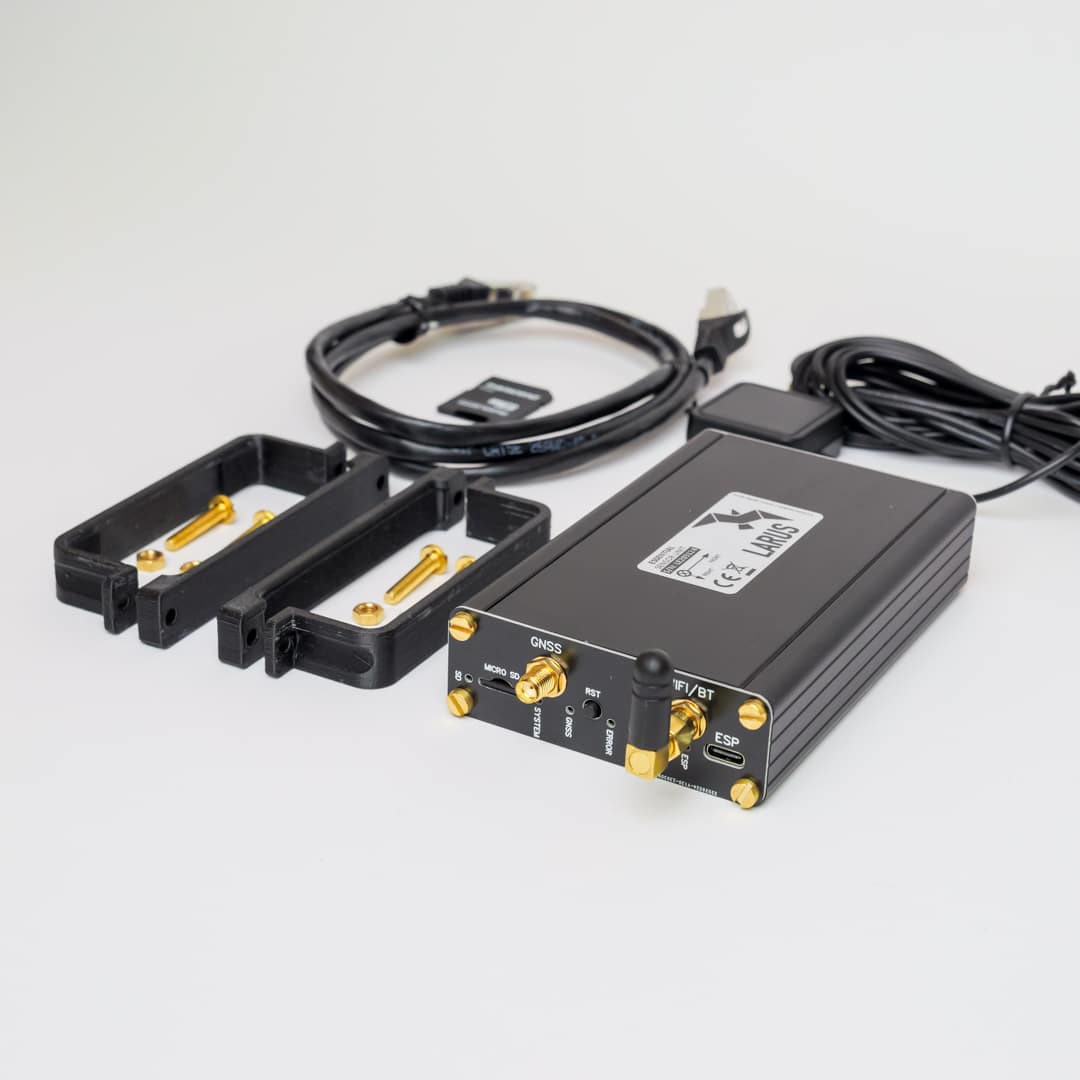


IMU
Inertial Measurement Unit (IMU) describes an inertial measurement unit that combines several inertial sensors. LARUS relies on the high-quality IMU XSENS MTi-1. It measures three-dimensional acceleration, yaw rate and magnetic field.
The flight attitude is calculated from this data by comparing it with the speed data of the GNSS (AHRS function).
When circling, the heading is determined by comparing the acceleration (determined from the flight path using the GNSS positions) and the AHRS. You don't need a magnetic compass for this. The Larus sensor unit automatically determines the calibration of the magnetic compass during circling flight, so that it can then be used to measure the magnetic heading in straight flight. Together with the adjustable magnetic declination, true heading (relative to true north) can be measured with an accuracy of about 1-2 degrees.
With LARUS Dual-GNSS, the accuracy of the heading can be improved to approx. 0.05 degrees by using a D-GNSS "compass" (2 coupled differential GNSS receivers, here uBlox F9P).
The flight attitude measurement can be used for an artificial horizon as well as for the precise display of the current drift angle (track – heading).

Pressure Sensors
The Larus sensor box contains pressure sensors for measuring static pressure and dynamic pressure. The static pressure is required to display the pressure altitude and the flight level FL. It is also used to determine air density.
The indicated airspeed IAS is formed from the dynamic pressure.
The true airspeed TAS is calculated from the indicated airspeed, taking into account the current air density. LARUS calculates the air density in real time by comparing the GNSS altitude with the pressure altitude, without having to measure the temperature or humidity. LARUS then uses the TAS to calculate the wind speed.


Description of the algorithms

- In straight flight, the time period for short-term wind is 5 s and for long-term wind 30 s (default setting; both times are configurable)
- When circling, the short-term wind is the mean of the last circle, while the long-term wind is the accumulated mean over the entire time of the last circling phase
Calculation of (real-time) wind speed
LARUS determines the wind speed from the three-dimensional difference between ground speed and flight speed. Both a short-term mean value and a long-term mean value are output. The periods differ as follows:
A special algorithm detects and eliminates deviations in circular flight that result from a change in the angle of attack.
Variometer
The LARUS sensor uses a Kalman filter to combine GNSS altitude, GNSS speed and vertical acceleration determined by the Inertial Measurement Unit (IMU).
This algorithm has virtually no inertia and provides a highly accurate (uncompensated) variometer instantaneously and without using pressure data.
The speed compensation is generated by differentiating the speed through the air. For this purpose, the ground speed of the GNSS and the average horizontal wind speed are used to calculate the kinetic energy of the three-dimensional movement.

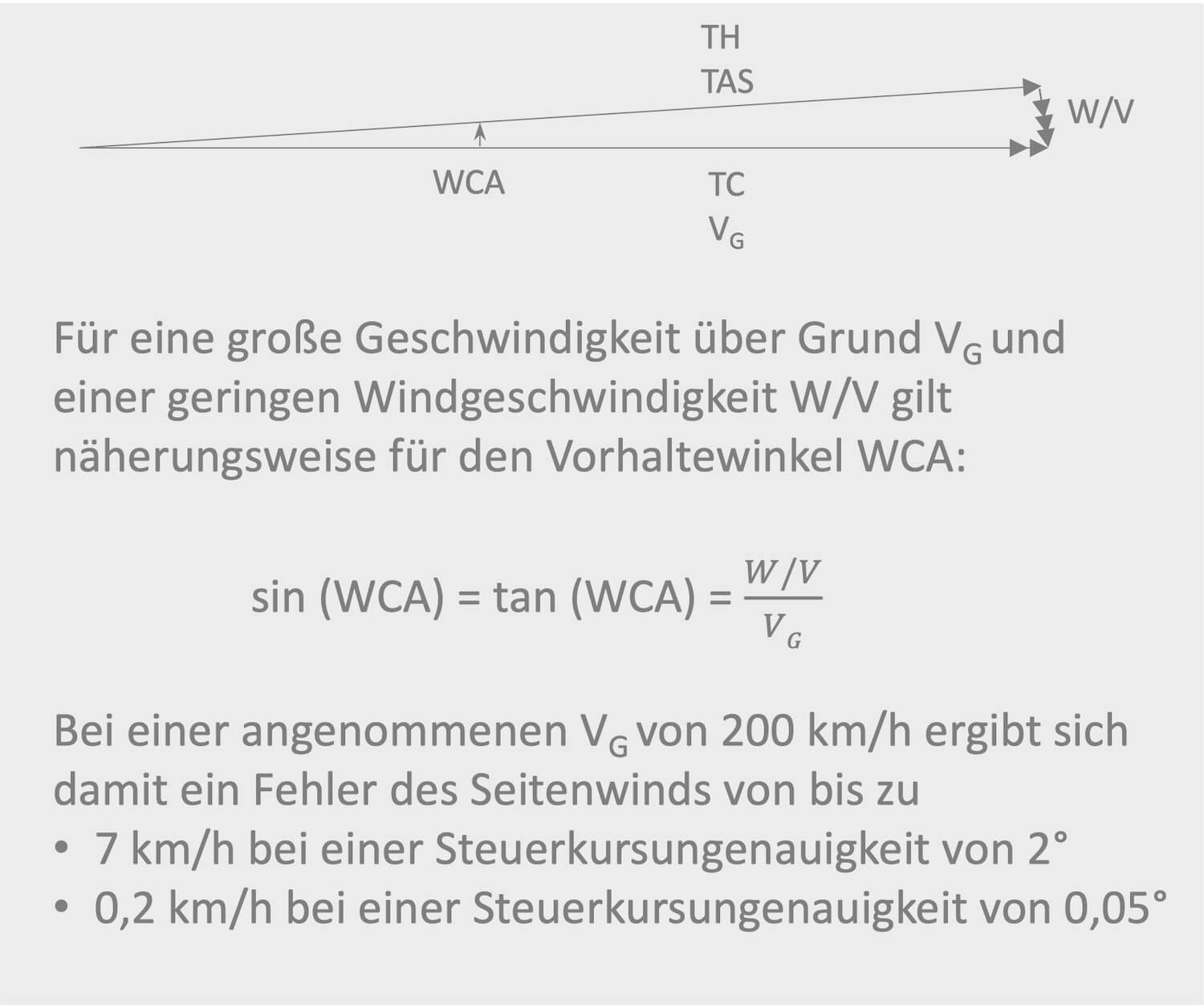
Influence of the heading accuracy on the wind calculation in forward flight
As described above, the LARUS Essential (uBlox M9N single-frequency receiver) already achieves a high heading accuracy of 1-2° (under optimal installation conditions, see below).
In contrast, the accuracy of heading determination with the Dual-GNSS variant is outstanding at 0.05°. This is particularly advantageous at high airspeed in level flight. As the wind triangle illustrates, at an airspeed of 200 km/h, 2° corresponds to a 7 km/h inaccuracy in the crosswind component, while 0.05° corresponds to only a 0.2 km/h inaccuracy.
In addition, the accuracy of the dual GNSS version is not affected to the same extent as LARUS Essential if iron parts or magnetic fields in the vicinity of the LARUS sensor unit cannot be avoided due to the installation situation. Due to the two GNSS receivers, only a small part of the measured values from the IMU flows into the algorithm.
Installation Instructions
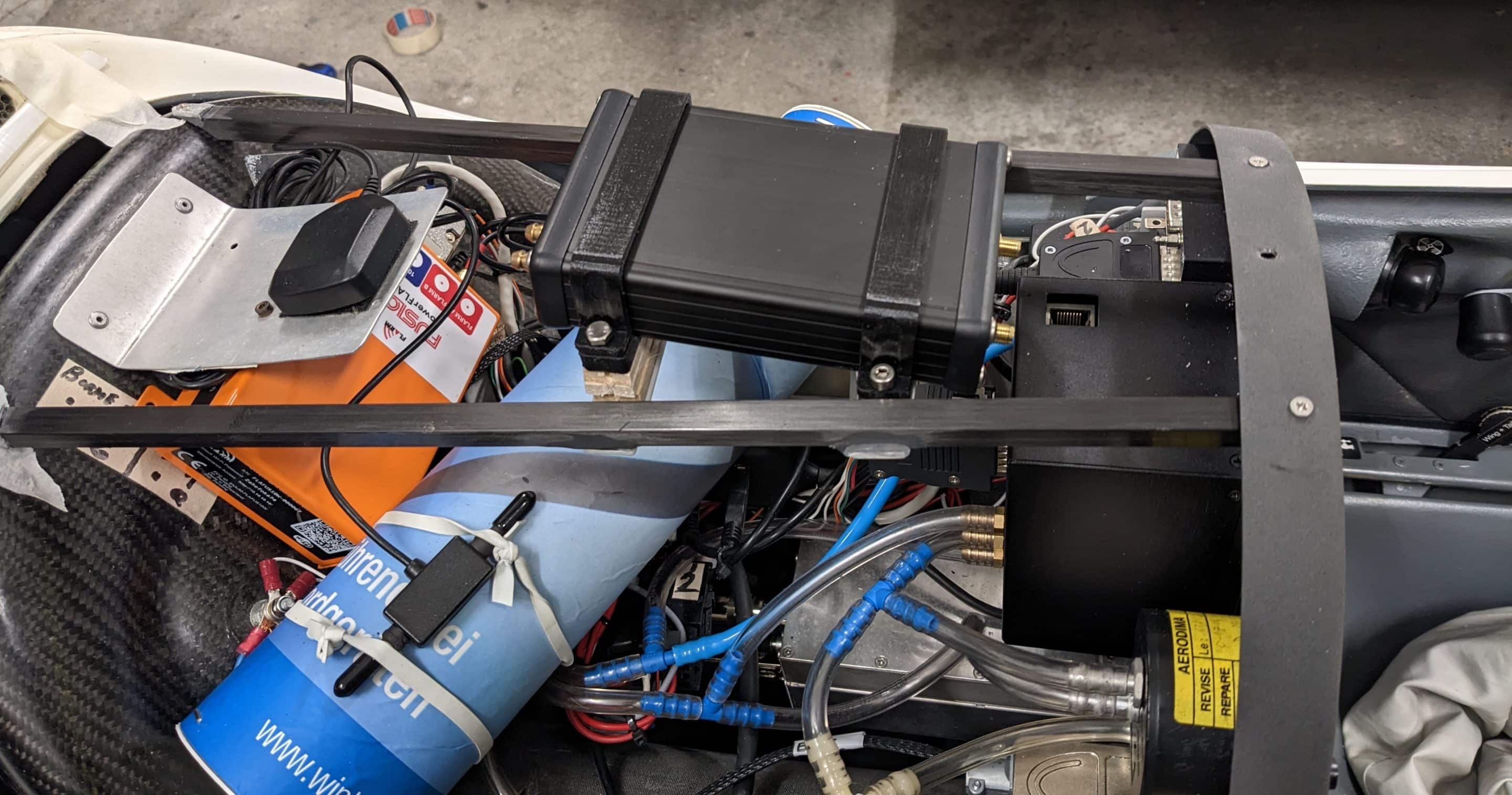
In a nutshell:
- Mount the sensor unit absolutely fix so that the position of the sensor unit in relation to the aircraft structure does not change under the influence of acceleration forces
- The LARUS sensor must be positioned as far away as possible from magnetic fields and bigger iron parts
- The installation orientation of the LARUS box is possible in all directions and only needs to be adjusted in the configuration file "sensor_configuration.txt". Nevertheless, we recommend to select the orientation with regard to the longitudinal axis of the aircraft during assembly according to the coordinate system printed on the LARUS housing. Ideally, the LARUS sensor unit is also mounted in such a way that it is roughly horizontal in normal flight.
- The GNSS antennas must be mounted in such a way that there is "line of sight" to as many satellites as possible. For this reason, they must be installed in the instrument panel or fuselage tube approx. in-flight-horizontal and above electrically conductive materials. CFRP is also one of the electrically conductive materials.
Explanations regarding LARUS Essential
A requirement for the high accuracy of LARUS Essential is that the disruptive influence of magnetic fields in the vicinity of the sensor unit is minimized. This is particularly high priority for LARUS Essential. In particular, the correct operation of the inertial measuring unit IMU, which among other things measures the magnetic induction, is severely impaired by magnets, changing magnetic fields or iron parts. We recommend keeping the LARUS sensor unit as far away as possible (at least 20 cm), especially from speakers and magnets (often contained in GPS / GNSS antennas, simply check with magnets). In addition, the fastening elements in the immediate vicinity of the sensor should be made of stainless steel, brass, plastic, aluminum or fiber composite materials and the usual nuts and bolts made of steel should be avoided. Iron parts are unsuitable because they generate a variable interference field with every movement of the aircraft.
The GNSS antenna, on the other hand, is not sensitive to magnetic fields.
Explanations regarding LARUS Dual-GNSS
Bei LARUS Dual-GNSS ist dagegen wichtig, dass die beiden GNSS Empfänger einen Abstand von mind. 1,0 Metern zueinander aufweisen.
The master GNSS antenna should be mounted on the inside of the fuselage tube (luggage compartment / end of the canopy) approximately above the center of gravity of the aircraft. Because the shorter the distance between the antenna and the center of gravity, which is also the center of rotation of the aircraft around the pitch axis, the less the influence of pitching movements (forward or backward movement of the stick) on the measured altitude.
The second antenna (slave GNSS antenna), on the other hand, is mounted at the level of the instrument panel or in front of it in the nose of the aircraft.
Für alle GNSS-Antennen ist wichtig, dass das Laminat oberhalb der Antennen aus GFK und nicht aus CFK besteht, da ansonsten aufgrund der elektrischen Leitfähigkeit von Kohlenstofffasern die Dämpfung zwischen GNSS Satellit und Empfänger im Flugzeug zu groß wäre. Bei Flugzeugen mit CFK-Rumpf kann allerdings auch eine Montage der Antennen im vorderen und hinteren Bereich der Haube in Betracht gezogen werden, sofern die Antennen dann einen ausreichenden Abstand (ca. 1,0 m) zueinander aufweisen.
How is the information presented in XCSoar?
OpenSoar with LARUS driver
In order to clearly present the results of the calculations of climb values, wind and position in space, Uwe Augustin has integrated a driver for LARUS into OpenSoar. The variometer display known from XCSoar uses the precise LARUS data. XCSoar continues to produce the vario sound, although no speed-to-fly option is currently implemented.
The fact that LARUS is on board is revealed when you look at the display. You will see two separate wind arrows, which are shown directly in the moving map. In this way, the direction and strength of the current wind and the wind averaged over a longer period of time are visualized. In addition, new wind-related info boxes are available.
Another novelty is the artificial horizon, which is displayed on a separate page in OpenSoar. It is helpful, for example, to check the correct function and calibration of the IMU after installing the sensor unit.
Link to OpenSoar: https://opensoar.de/releases/
LARUS data in a separate round instrument
Thanks to OpenSoar, it is already possible to use a large part of the functionality of LARUS. Only an OpenVario or a device running XCSoar is required.
However, we would like to give all pilots the opportunity to use the LARUS glider sensor, regardless of whether XCSoar or an OpenVario is already on board. Therefore we are working on separate round instruments that present all information from LARUS gliding sensor in a clear and visually appealing way. Market launch is planned for end of this year.
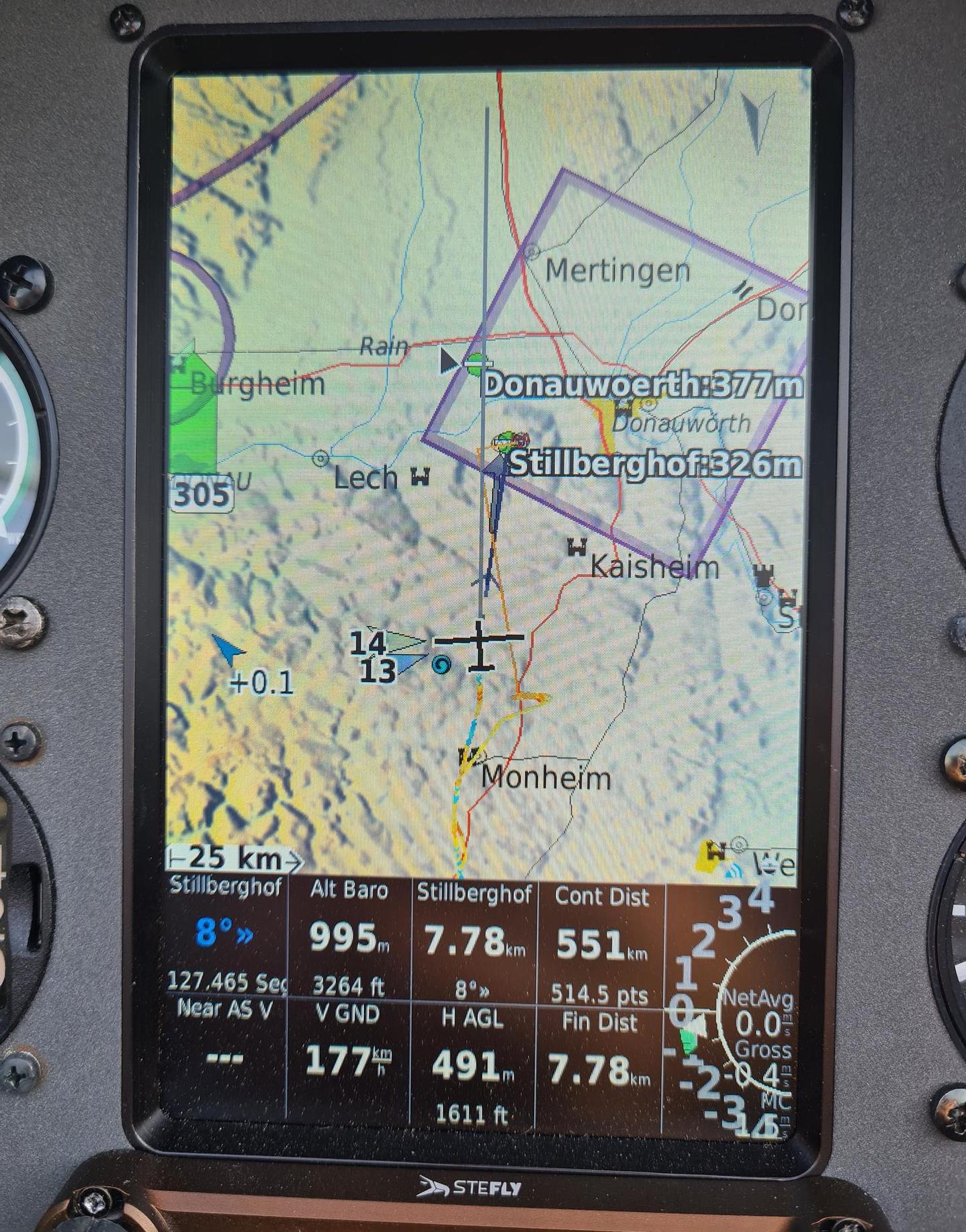
What does LARUS mean?
Larus is the name for a gull genus that includes several of the largest gull species. Gulls are not only experts at taking advantage of slope winds, they are also dedicated thermal flyers. Their senses, instinct, and a lifetime of practice make seagulls a role model for us glider pilots. The LARUS gliding sensor unit aims to provide us pilots with the sensors and the precise information derived from them that we need for gliding due to a lack of suitable sensory organs: speed and altitude, wind direction and strength, rise or sink of the surrounding air.
Let us glider pilots use the energy in the atmosphere to full capacity!

LARUS License
Larus hardware is licensed accordingly to Creative Commons NonCommercial Share-alike 4.0 International, Larus software accordingly to GNU General Public License v3.0.
License fees ensure long-term further development.

Installation / Operating Manual
The current version 1.51 (July 2024) of the instruction for installation and operation can be found here!
Installation Manual and Operating Instructions
STM32 Update DE
STM32 Update EN
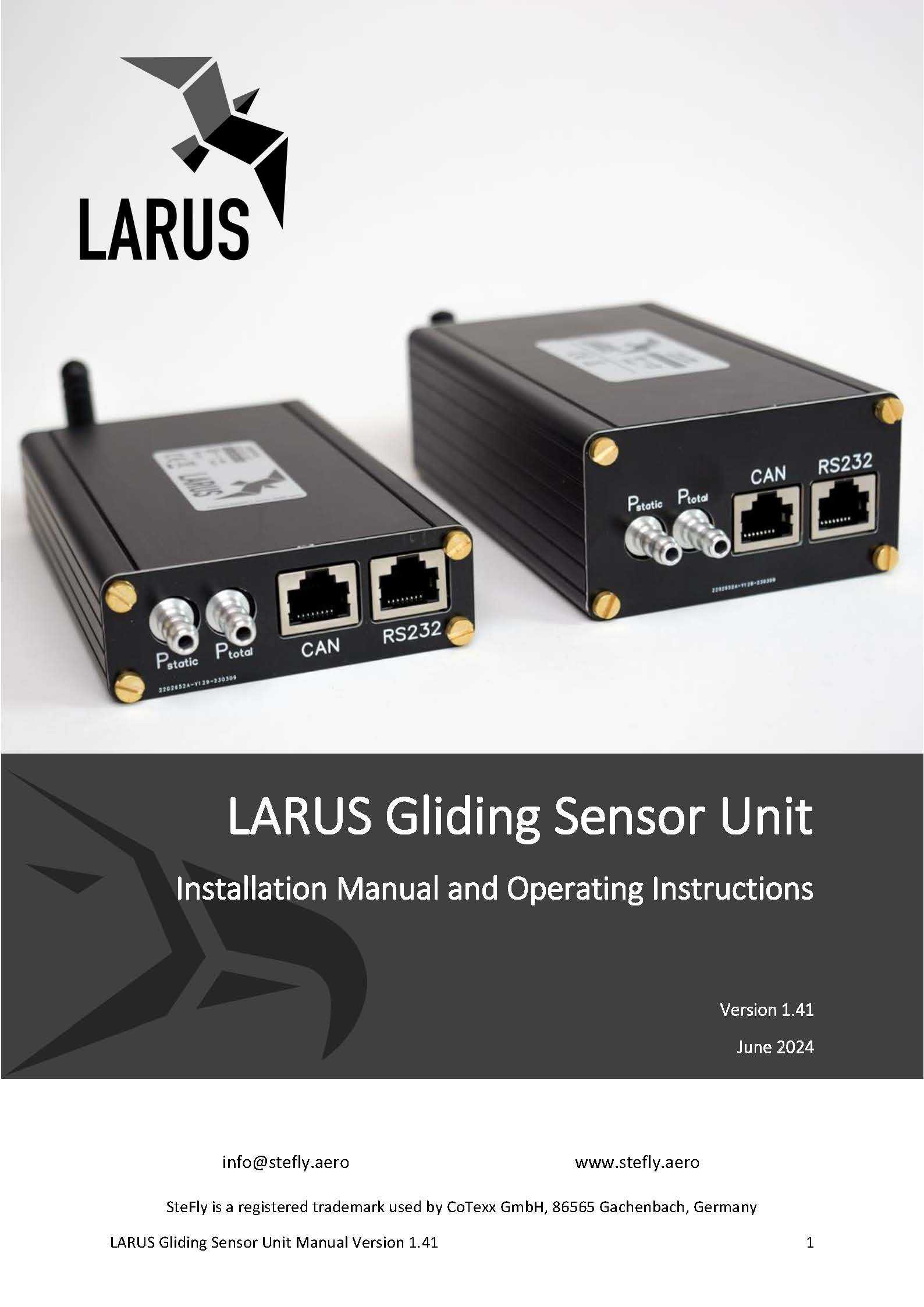
How can you install the dual GNSS antennas in a carbon fibre glider?
Carbon fiber is electrically conductive and will block the GNSS signal. Some carbon fibre gliders like the ASG29 have a glas fiber window above the luggage compartment. If your glider is entirely made out of carbon fiber, then you can only install the GNSS antennas at the front and back of the canopy.
Are all cables and the software included in the scope of delivery?
Included are: Single GNSS or Dual GNSS antennas, fastening clamps incl. screws, 1 m RJ45 cable to connect to OpenVario/XCNav/XCTouchNav, 4 Gb Micro SD card
The firmware is pre-programmed and software updates can be installed with a USB-C cable.
https://github.com/larus-breeze/sw_sensor
The sensor box can be used as an artificial horizon? Is it possible to block this feature for competitions?
LARUS provides AHRS data to XCSoar. This AHRS is not certified and you should not fly with it in non-VFR conditions! At the moment there is no possibility to deactivate the AHRS in the LARUS Sensor but we are working on a solution.
Technical Data
Input voltage range: 9 bis 28V DC (RJ45), 5 V USB-C
Amperage @ 13 V DC: LARUS Essential 120 mA, LARUS DUAL-GNSS 150 mA
Interfaces: RS232 (x2) - RJ45 / CAN (x1) - RJ45 / Bluetooth - SMA reverse polarity / GNSS-Antenna - SMA normal polarity / microSD
Hose Connector Diameter: 6 mm
Operating Temperature: -30°C to +60°C
Dimensions of LARUS Essential housing: 145 mm x 79 mm x 28 mm (incl. antenna connectors and hose connectors)
Dimensions of LARUS Dual-GNSS: 145 mm x 79 mm x 43 mm (incl. antenna connectors and hose connectors)
Weight LARUS Essential: 300 g (incl. GNSS antenna)
Weight LARUS Dual-GNSS: 630 g (incl. 2 GNSS antennas)
Material: black anodized aluminum housing
Cable length GNSS antennas: LARUS Essential 4 m, LARUS Dual-GNSS 5 m

